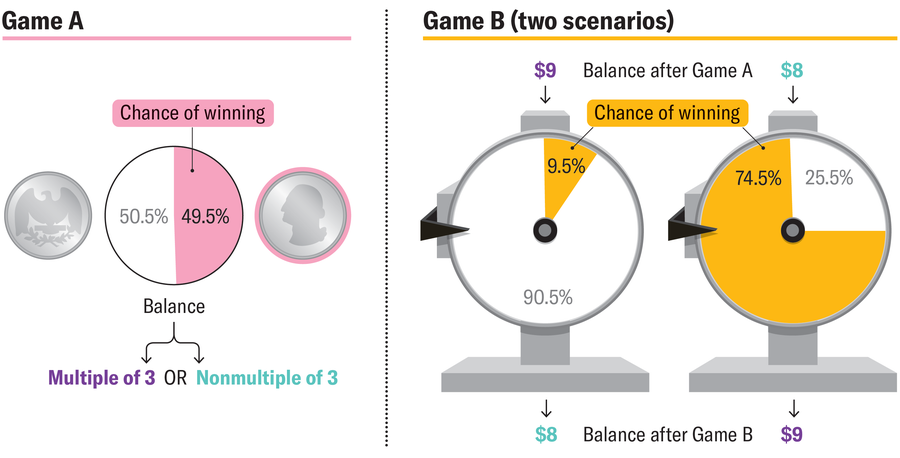October 16, 2025
5 min read
A Mathematical Paradox Shows How Combining Losing Strategies Can Create a Win
In certain circumstances, losses create a sure path to victory, an idea with implications for biology and cancer therapy
Filo/Getty Images (images); Scientific American (animation)
In 1996 Spanish physicist Juan Parrondo made an incredible discovery: sometimes two games that each end in loss individually can be combined into a winning strategy. This paradox is no mere mathematical curiosity—it’s scientifically useful. It helps explain the varied life histories of slime molds and could contribute to new cancer therapy strategies.
To understand this paradox, we need to imagine a situation in which you play two games with some very specific parameters. For instance, let’s imagine that the first game, “A,” involves a coin toss. The coin in this case has a weight distribution has been slightly altered so that it lands preferentially on one side with a probability of 50.5 percent. Now let’s assume that Game A is somewhat rigged so that I win if it lands on the preferred side and you win if it lands on the other side. You can therefore only win with a probability of 49.5 percent and, in this case, I will give you $1; otherwise you will pay me the same amount.
If you play Game A against me many times, you will inevitably sustain a lot of losses because you have to pay me an average of one cent per game. (We can calculate that quickly by taking the likelihood of your win and subtracting the likelihood of my win: 0.495 – 0.505 = –0.01.)
On supporting science journalism
If you’re enjoying this article, consider supporting our award-winning journalism by subscribing. By purchasing a subscription you are helping to ensure the future of impactful stories about the discoveries and ideas shaping our world today.
Then there is a second, more complicated game, “B,” that involves spinning two wheels of fortune. For this game, you will get to spin one or the other based on how much money you currently have. If your available capital for the game (based on how you’ve been playing A) is evenly divisible by 3, then you spin a wheel of fortune that gives you a chance of winning of only 9.5 percent. If, on the other hand, your capital is not divisible by 3, then you get better odds: you spin another wheel that gives you a 74.5 percent chance of winning.
Now things get interesting.
Two Games You Can Only Lose
In Game B, the stake is once again $1. On average, you will lose 87 cents per spin.
Let’s dig into that. You might assume that one third of the time, you will spin the wheel that’s unfavorable for you and two thirds of the time, you will spin the other wheel. But that’s incorrect because your money doesn’t fluctuate evenly. For example, if you have $9, you’ll spin the unfavorable wheel and will likely lose, leaving you with only $8. If you play the game again with that amount, however, you’ll spin the wheel that’s more favorable for you and will have a higher chance of winning. So you’ll end up with $9 again.
The probability that you have sum of money divisible by 3 is therefore significantly more than one third. Using a complicated procedure known as a Markov chain, you can calculate that your overall probability of winning Game B is just 49.565 percent—and your expected profit per round is negative: 0.49565 – 0.50435 = –0.0087.

A Paradox Appears
If you’re smart, you wouldn’t play against me in either Game A or Game B. In both cases, you’re bound to lose in the long run. But Parrondo realized that a mixed strategy can pay off: by alternating between Games A and B, you can actually win overall.
For example, if you always play two rounds of Game A followed by two rounds of Game B, you’ll win an average of 1.48 cents per round. Or if you follow each A round with two B rounds, you’ll earn an average of 5.8 cents per round. So in the long run, you’d see a profit in both cases.
As Parrondo discovered, there are more combinations of A and B that have a positive expected value for you than vice versa. Therefore, you emerge as a winner even if you randomly choose whether to play A or B each round (for example, by letting a fair coin decide). In this case, your average win is 1.47 cents per round.
How is this possible? The key to the Parrondo’s paradox is that the two games A and B can influence each other because Game B depends on the money you currently have, and that amount fluctuates as you play Game A. Therefore, A and B can no longer be viewed as independent games. This is the core of Parrondo’s paradox. If Game B were modified so that, for example, the value of a die determined which wheel of fortune you would spin, the paradox would disappear because both games would be completely independent of each other.
Applications of Parrondo’s Paradox
Since Parrondo’s surprising publication in 1996, numerous papers have appeared on the topic. In 2017 two computer scientists demonstrated that this paradox can explain the varied life strategies of slime molds, which can alternate between a solitary, nomadic life and a stationary colony.
In some situations, it’s more advantageous for these beings to gather together to form colonies instead of existing as solitary wanderers. But these communal living arrangements cannot survive in the long run either: the organisms exploit their environment, and eventually the resources start to deplete. Sticking to one strategy would inevitably lead to death, but a mixed strategy offers a solution: the organisms temporarily become mobile again while the environment in a particular area regenerates.
Computational physicist Jian-Yue Guan of Lanzhou University in China and her colleagues presented another application of Parrondo’s paradox in a paper published in Physical Review E in August 2025. For many types of cancer, two different approaches to chemotherapy are used. Patients either receive the maximum tolerated dose at specific intervals or they are treated continuously with a low dose. The first strategy has the disadvantage that some tumor cells develop resistance and thus do not respond to the medication. In the second strategy, the drug concentration is not always high enough to completely eradicate all cancer cells.
Through computer simulations, the researchers demonstrated that switching between the two medication approaches at set times could lead to better results even without detailed monitoring—much like a random order of A and B is advantageous in the lottery example. Whether this theoretical approach can truly be applied to cancer medicine needs further investigation. Guan and her team plan to test their ideas with in vitro studies.
This article originally appeared in Spektrum der Wissenschaft and was reproduced with permission.

